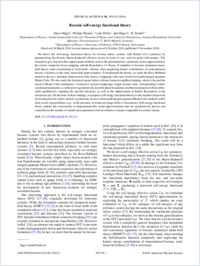Bosonic self-energy functional theory
- Hügel, Dario Department of Physics, Arnold Sommerfeld Center for Theoretical Physics and Center for NanoScience, Ludwig-Maximilians-Universität München,Germany
- Werner, Philipp Department of Physics, University of Fribourg, Switzerland
- Pollet, Lode Department of Physics, Arnold Sommerfeld Center for Theoretical Physics and Center for NanoScience, Ludwig-Maximilians-Universität München,Germany
- Strand, Hugo U. R. Department of Physics, University of Fribourg, Switzerland
-
09.11.2016
Published in:
- Physical Review B. - 2016, vol. 94, no. 19, p. 195119
English
We derive the self-energy functional theory for bosonic lattice systems with broken U(1) symmetry by parametrizing the bosonic Baym-Kadanoff effective action in terms of one- and two-point self-energies. The formalism goes beyond other approximate methods such as the pseudoparticle variational cluster approximation, the cluster composite boson mapping, and the Bogoliubov+U theory. It simplifies to bosonic dynamical-mean-field theory when constraining to local fields, whereas when neglecting kinetic contributions of noncondensed bosons, it reduces to the static mean-field approximation. To benchmark the theory, we study the Bose-Hubbard model on the two- and three-dimensional cubic lattice, comparing with exact results from path integral quantum Monte Carlo. We also study the frustrated square lattice with next-nearest-neighbor hopping, which is beyond the reach of Monte Carlo simulations. A reference system comprising a single bosonic state, corresponding to three variational parameters, is sufficient to quantitatively describe phase boundaries and thermodynamical observables, while qualitatively capturing the spectral functions, as well as the enhancement of kinetic fluctuations in the frustrated case. On the basis of these findings, we propose self-energy functional theory as the omnibus framework for treating bosonic lattice models, in particular, in cases where path integral quantum Monte Carlo methods suffer from severe sign problems (e.g., in the presence of nontrivial gauge fields or frustration). Self-energy functional theory enables the construction of diagrammatically sound approximations that are quantitatively precise and controlled in the number of optimization parameters but nevertheless remain computable by modest means.
- Faculty
- Faculté des sciences et de médecine
- Department
- Département de Physique
- Language
-
- English
- Classification
- Physics
- License
-
License undefined
- Identifiers
-
- RERO DOC 278702
- DOI 10.1103/PhysRevB.94.195119
- Persistent URL
- https://folia.unifr.ch/unifr/documents/305296
Statistics
Document views: 109
File downloads:
- pdf: 175
